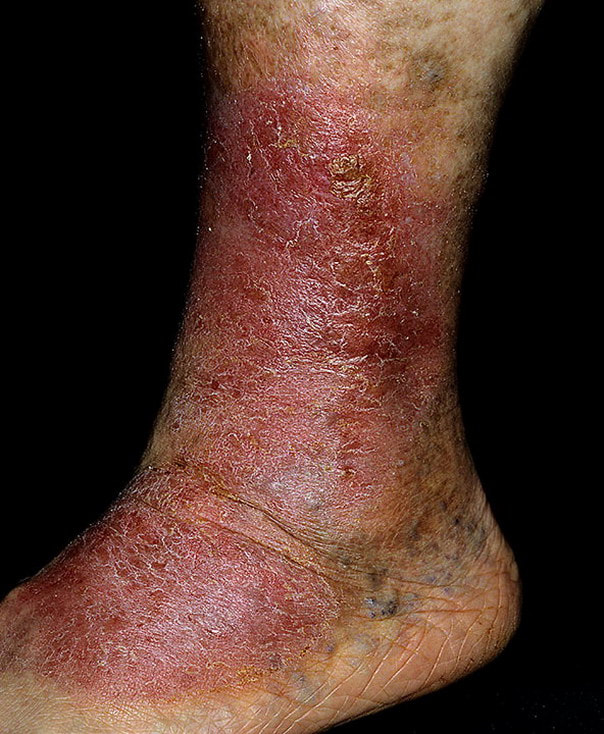Stasis Dermatitis - Causes, Symptoms & Treatments By Pierre Mouchette | Bits-n-Pieces What is in a name?
Stasis dermatitis, the name of this inflammatory skin disease, describes it best. Stasis means staying still or pooling; dermatitis is a fancy word for a rash (skin inflammation). Therefore, stasis dermatitis is a skin rash caused by fluid pooling in the lower legs (edema). It is common, affecting about 6% of people over 65. What causes stasis dermatitis? To understand what stasis dermatitis is, it is helpful to understand what veins and edema are. Veins are the blood vessels that send blood to the heart. When we sit or stand, the blood vessels struggle to return blood from the legs to the heart. Valves inside the veins help prevent blood backflow, and the leg muscles squeeze the blood. However, valves in the vein start to leak with age, and the leg muscles do not squeeze the blood up if we do not move around. The fluid then pools in the legs, causing edema. When edema is caused by veins that do not adequately return blood to the heart, it is called chronic venous insufficiency. Some individuals with this condition can develop stasis dermatitis. It is unclear why people with chronic venous insufficiency get stasis dermatitis and others do not. We do know that stasis creates elevated pressure in veins, initiating inflammation and skin changes. Who is most at risk for stasis dermatitis? Age is a significant risk factor for stasis dermatitis because valves in the veins do not work as well over time. People over 50, especially women, are most likely to develop stasis dermatitis. Anything that causes prolonged fluid pooling in the legs will also raise the risk of stasis dermatitis! For example, factors such as:
What are the symptoms of stasis dermatitis? Stasis dermatitis typically affects the feet, ankles, and lower legs on one or both sides. Rarely does it affect other parts of the body. But, edema and rash are always present since you cannot have stasis dermatitis without stasis and dermatitis. The rash may appear red or brown in lighter skin tones or purple, brown, gray, or ashen in darker skin tones. Other symptoms of stasis dermatitis include:
What are the complications of stasis dermatitis? When severe, stasis dermatitis may cause venous ulcers (open sores). Since circulation is poor, venous ulcers take a long time to heal and often require special care. Stasis dermatitis may also lead to a skin infection (cellulitis), especially if there are openings in the skin. How is stasis dermatitis diagnosed? Healthcare providers can typically diagnose stasis dermatitis just by looking at it. The diagnosis is straightforward when edema and a discolored, dry, scaly rash are present. Sock line indentations in the skin from your socks at the end of the day are also an easy clue that edema is present. Are there treatments for stasis dermatitis? Yes, the treatment of stasis dermatitis involves three parts:
Decreasing fluid pooling in the legs To decrease fluid pooling in the legs, healthcare providers might recommend the following:
Caring for skin Skin affected by stasis dermatitis is dry, inflamed, itchy, and uncomfortable. Keeping the skin moisturized and avoiding scratching is critical to healing and preventing issues. To care for skin affected by stasis dermatitis, your healthcare provider might recommend the following:
0 Comments
Your comment will be posted after it is approved.
Leave a Reply. |
Archives
May 2024
|
